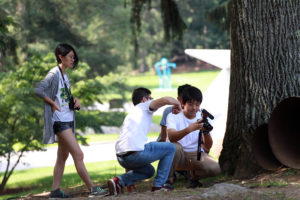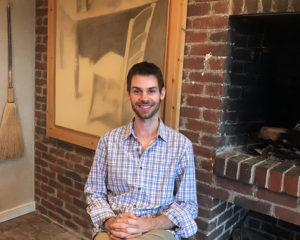Film or video is often used as a tool to tell a story or record an event. But Lincoln’s Tom Flint is trying to expand that tool to bring together people from different cultures through the process of creating a video.
The goal of each program is not to teach students how to make films in the usual way (writing a script, creating storyboards, and shooting preplanned scenes)—“just executing what you’ve already decided,” Flint said. “I’m interested in other ways students can grow from the process, not focusing exclusively on making a good-looking product. It’s a discovery-based approach to filmmaking where the students don’t know what film they’re even making until they’re finished.”
Flint earned his master’s degree in art and design education from the Rhode Island School of Design last year after spending 13 years in Japan, where he taught English and film and did freelance film work. When he first arrived, he struggled to learn Japanese, but over time, he became immersed in the country’s culture and eventually married a Japanese woman. They now live with their two-year-old daughter on the Lexington Road farm where Flints have lived continuously since the 1600s (Tom’s mother, sisters, and brother-in-law also live there).
Last summer, Flint’s organization, Zoom-In, Zoom-Out, led a workshop where local high school students teamed up with some of his former students from Japan, shooting video at deCordova Sculpture Park, Lincoln-Sudbury Regional High School, and Mt. Auburn Cemetery. Over the course of three days, the students got to know each other and then collaborated in planning, shooting, performing, and editing eight-minute videos. They used a video camera but no lights, tripods or special sound equipment, and did the editing on a computer.
There were just a few basic rules: the theme was “In Between,” and each film had to have a beginning, a middle and end, and had to have some kind of narrative twist. The story had to contain at least one identity-oriented memory from each member of the team, and the dialogue needed to incorporate each team member’s native language. The resulting films offer glimpses of how the students saw each other and the places they were in. They combine elements of cinema verité, scenic videography, and mood-creating story sequences with actors speaking in English or Japanese (usually without subtitles).

Checking the footage they just shot at deCordova are Mew Kano, Enzo Goodrich of Lincoln, and Keietsu Fukushima.
Along with Flint, the workshop was guided by Hiroyuki Oda from Gunma Kokusai Academy in Japan, and Paul Sarapas, the media and visual arts teacher at L-S.
Flint held a similar workshop at RISD over the summer where American high school students teamed up with teenagers from the Congo, Syria, and Afghanistan involved with the nonprofit Refugee Dream Center in Providence, which helps families who have been granted asylum to assimilate to life in Providence. “That turned out to be a fantastic experience as well, but so different from the one before,” he said.
Flint works with younger kids as well. This past fall, he led a film-making workshop at the Birches School in Lincoln. Eventually he hopes to offer after-school filmmaking programs for students in diverse communities in Rhode Island and Massachusetts, and eventually abroad.
“The overall goal is to break borders and build bridges among kids who would never otherwise meet each other,” Flint said.

TOM, JUST READ THIS AND LOVED IT. I NOW UNDERSTAND YOU AND ALL OF YOUR COMPLEXITIES THAT I LOVE AND ADMIRE.
CONTINUE THIS WONDERFUL WORK AND I WISH YOU ALL OF THE VERY BEST TO COME YOUR WAY AND THE WAY FOR ALL THE NEAT STUDENTS AND NON STUDENTS YOU WORK WITH!!
TAKE GOOD CARE! KATINA PENDLETON